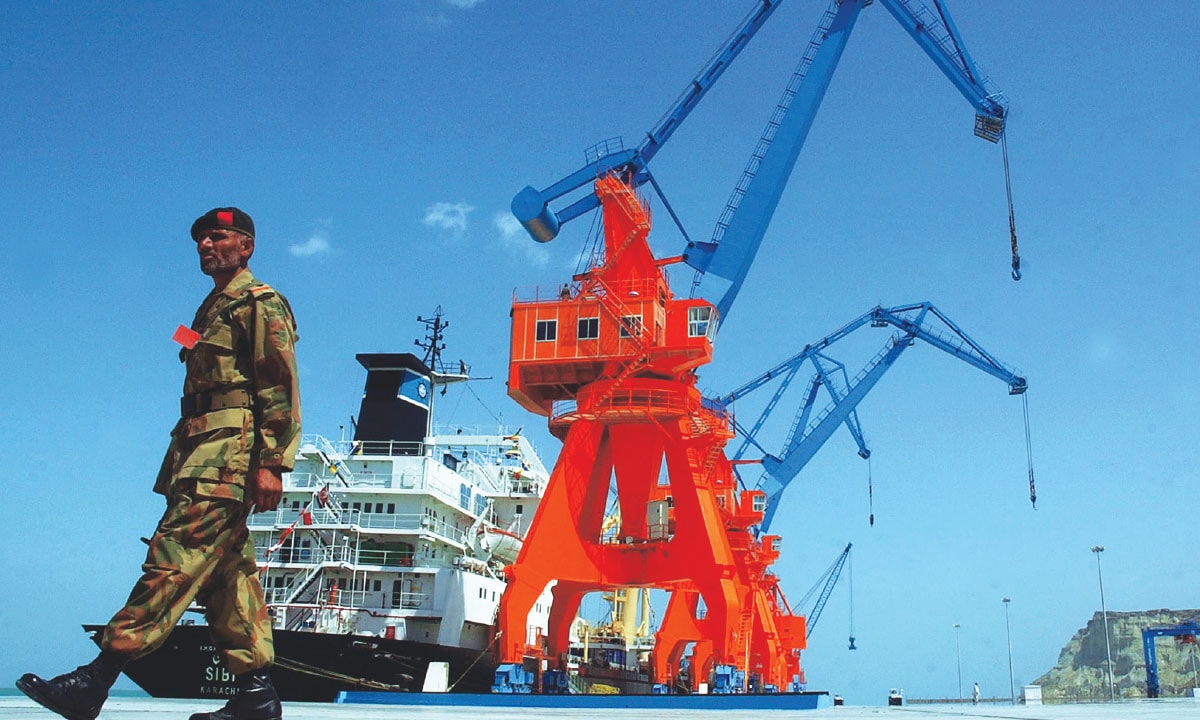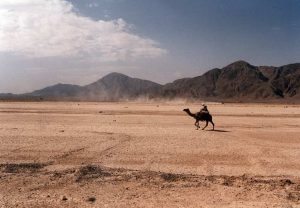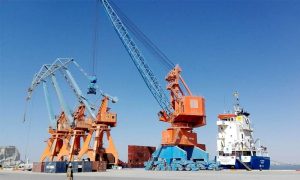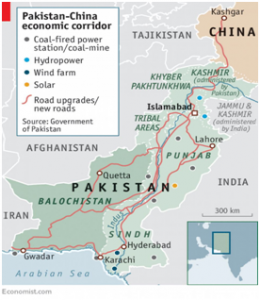https://bharatshakti.in/the-weak-heart-of-cpec-neglected-beyond-repair/




Image Courtesy: Herald Magazine - Dawn
Editor’s Note
We have already published a fairly large number of articles by the author on the China Pakistan Economic Corridor (CPEC) in BharatShakti. in. This article focuses primarily on the cascading effects of the CPEC on Baluchistan. Baluchistan, apparently, will barely have marginal gains while contributing the most among the Pakistani provinces for CPEC. The protests of the locals are already audible and are likely to rise in decibel levels as the project progresses.
The Weak Heart of CPEC – Neglected Beyond Repair?
Weak Heart Concept. Internationally, Baluchistan has been accepted as the weak heart of CPEC. Weak hearts need exceptional care and treatment. However, the irregular palpitations of this weak heart are being ignored. Historically, Baluchistan has been thoroughly neglected by Pakistan. The trend continues even though a lot of noise is being made to the contrary by the CPEC planners. Will the heart of CPEC, subject to continued neglect induce a cardiac failure to Pakistani dreams of transformation? Will the CPEC change the fates of Pakistan and China as per their ambitions? Or will the outcomes be vastly different? Let us see some base facts in this saga of dreams. Thereafter draw your own conclusions.
Neglect of Baluchistan – Under Debate.

Image Courtesy: The Newsblog – The News International
Baluchistan is the main entry point into this corridor with the arrow’s head at Gwadar. With its vast expanse of land, long sea coast, the mega-port of Gwadar and its natural resources, Baluchistan, is undoubtedly the heart of CPEC. Much of what happens to the CPEC and Pakistan will hinge around the outcomes in Baluchistan. There is a debate in Pakistan about the neglect of Baluchistan. Influential and respected voices are raising concerns regarding issues involved. Equally, voices from the Government and Army are countering and drowning these concerns. It is time to understand some of the issues at stake.
Resource Rich – Socially Poor. Baluchistan is the largest province of Pakistan, covering 44% of the country’s area, but is home to only 5% of the country’s population. It has abundant natural resources, a vast rangeland, an underdeveloped coastal belt of 750 km with a deep-water port and is rich in mineral and hydrocarbon deposits. However, since Independence, Baluchistan has been neglected and deprived by the Pakistani State. Look at some of the current social indicators. 70 % people of Baluchistan live in poverty. Malnutrition, Infant and Maternal mortality rates are thrice that of rest of Pakistan. Female literacy and school enrolment range between 40-50% of Pakistani averages. Village electrification is 1/3rd of Pakistan. Pretty grim even by the dismal Pakistani standards!
Resource Diversion and Deprivation. The resources of the state have been systematically diverted by the Pakistani Federal Government to other states. Take the example of Gas. Gas was discovered in Sui in the 50s. It has been transmitted to Islamabad 900 km away and not given to Quetta which is just 360 km away. The excuse – not economically viable to send it to Quetta which is the capital of the state! Take the case further. Gas is the basic input for urea production. However, the nearest urea plant is in Mirpur-Mathello (in Sindh). Not a single urea plant in Baluchistan. More examples can be quoted, but it would suffice to say that in the past six decades, Baluchistan has been systematically deprived of development and employment while being continuously exploited. Obviously, the heart has had a history of weakness.
Promising the Moon. So, what is being done? Baluchistan is now being promised the moon. The lines in all talk shows and political meetings of CPEC represent a glib tongue. Gwadar will be developed. Infrastructure will be developed. Social programs will be implemented. The Baluchistan State will prosper. It will be the engine of Pakistani CPEC dreams. The ISPR of Pakistani Army has even come out with a video clip on it and is busy promoting the dream of a prosperous future for Baluchistan. It is a hard sell, but no one tells the people what is being done in concrete terms. The reality is far away in planning and practice. It is like undertaking a trip to Mars without oxygen in your engine.
Contribution and Returns from CPEC. Let us see what the Baluchistan engine is contributing to CPEC in comparison to other states. Some data aggregated from various Pakistani sources and approximated in a simplistic manner with marginal errors has been tabulated below: –
STATE WISE CONTRIBUTION OF RESOURCES TO CPEC
| Resource | Baluchistan | Sindh | Punjab | Khyber Pakhtunkhwa |
| Land | 50% | 30% | 10% | 10% |
| Sea | 70% | 30% | 0 | 0 |
| Port | 100% | – | – | – |
| Minerals | 60% | 20% | 15% | 15% |
| Coal | 30% | 60% | 5% | 5% |
| Gas | 35% | 50% | 6% | 9% |
| Environmental degradation suffered | 50% | 30% | 10% | 10% |
It has been surmised by experts that the overall contribution of Baluchistan to CPEC is approx. 60-65%.What does Baluchistan get in return? The planned projects and current investment pattern in CPEC (approximated) is as under:-
PLANNED PROJECTS AND INVESTMENT PATTERN OF CPEC
| Baluchistan | Sindh | Punjab | Khyber Pakhtunkhwa | |
| Planned projects | 2.6% | 33.7% | 57.5% | 6.2% |
| Current investment | 3.8% | 15.3% | 50.3% | 30.6% |
A state which contributes nearly 65% for the CPEC is going to get a share of less than 5%. On the other hand, Punjab contributes 10% resources and garners more than half the share of the pie. If that happens to me, I would be an angry man. So, it is understandable if the people of Baluchistan are angry. Well, these statistics could be debatable and contentious. Let us see some other facts gleaned from the CPEC website.
Energy and Power – Darkness Ahead.
Energy and Power generation is the single major investment avenue in the CPEC Plan amounting to nearly $37 Bn.  Out of the planned 19 power projects, there is only one in Baluchistan, that too for Gwadar. The spread of power projects in the CPEC plan can be very clearly seen in the map published by the Economist on 08 Sep 2017. Baluchistan is going to remain quite dark in comparison to the rest of the country. As an after-thought, if someone in Pakistan says that they will now put up power plants or transmit power from outside as an appeasement tactic, they are talking through their hat. There are no transmission lines. Baluchistan has only 27 km of 500 kv transmission lines out of a total of about 5000 km in Pakistan. Incidentally, a 500 kv transmission line is a basic pre-requisite for any major transfer of extra high voltages over long distances. There are only two high voltage lines planned as per the CPEC website and both do not pass through Baluchistan. Even if they are planned now (with diverted funding), the construction of unplanned power plants and transmission line laying process will span over the next two to three decades. So, Baluchistan will literally be kept in the dark till then despite the huge power basket of CPEC!
Out of the planned 19 power projects, there is only one in Baluchistan, that too for Gwadar. The spread of power projects in the CPEC plan can be very clearly seen in the map published by the Economist on 08 Sep 2017. Baluchistan is going to remain quite dark in comparison to the rest of the country. As an after-thought, if someone in Pakistan says that they will now put up power plants or transmit power from outside as an appeasement tactic, they are talking through their hat. There are no transmission lines. Baluchistan has only 27 km of 500 kv transmission lines out of a total of about 5000 km in Pakistan. Incidentally, a 500 kv transmission line is a basic pre-requisite for any major transfer of extra high voltages over long distances. There are only two high voltage lines planned as per the CPEC website and both do not pass through Baluchistan. Even if they are planned now (with diverted funding), the construction of unplanned power plants and transmission line laying process will span over the next two to three decades. So, Baluchistan will literally be kept in the dark till then despite the huge power basket of CPEC!
 Out of the planned 19 power projects, there is only one in Baluchistan, that too for Gwadar. The spread of power projects in the CPEC plan can be very clearly seen in the map published by the Economist on 08 Sep 2017. Baluchistan is going to remain quite dark in comparison to the rest of the country. As an after-thought, if someone in Pakistan says that they will now put up power plants or transmit power from outside as an appeasement tactic, they are talking through their hat. There are no transmission lines. Baluchistan has only 27 km of 500 kv transmission lines out of a total of about 5000 km in Pakistan. Incidentally, a 500 kv transmission line is a basic pre-requisite for any major transfer of extra high voltages over long distances. There are only two high voltage lines planned as per the CPEC website and both do not pass through Baluchistan. Even if they are planned now (with diverted funding), the construction of unplanned power plants and transmission line laying process will span over the next two to three decades. So, Baluchistan will literally be kept in the dark till then despite the huge power basket of CPEC!
Out of the planned 19 power projects, there is only one in Baluchistan, that too for Gwadar. The spread of power projects in the CPEC plan can be very clearly seen in the map published by the Economist on 08 Sep 2017. Baluchistan is going to remain quite dark in comparison to the rest of the country. As an after-thought, if someone in Pakistan says that they will now put up power plants or transmit power from outside as an appeasement tactic, they are talking through their hat. There are no transmission lines. Baluchistan has only 27 km of 500 kv transmission lines out of a total of about 5000 km in Pakistan. Incidentally, a 500 kv transmission line is a basic pre-requisite for any major transfer of extra high voltages over long distances. There are only two high voltage lines planned as per the CPEC website and both do not pass through Baluchistan. Even if they are planned now (with diverted funding), the construction of unplanned power plants and transmission line laying process will span over the next two to three decades. So, Baluchistan will literally be kept in the dark till then despite the huge power basket of CPEC!Mining for Waste. Chinese Metallurgical Construction Group (MCG) has been present in the Saindak copper project (near the Iranian border) for over a decade. Very interestingly the HQ of this project has been in Karachi and not in Baluchistan! Chinese presence will also extend to the Duddar lead-zinc project where there are estimates of million tons of lead-zinc reserves. Mining resources in Baluchistan are also in the process of being given to other Chinese companies to kick-start a boom in the mining industry by including it as part of CPEC. Interestingly all the deals are between the federal government and China. Nothing for Baluchistan. What the people of Baluchistan are assured of is the nuclear waste from Chagai Hills.
The Gwadar Story.

Image Courtesy: Dawn
Consider Gwadar port itself. The arrowhead of CPEC is already under Chinese ownership. Exclusive Chinese colonies have come up. Pakistan is under pressure to accept the Yuan as legal currency/tender. Ipso facto – Chinese Sovereign territory already? Locals have been shooed away without a rehabilitation plan. There is a huge land mafia in operation there with roots in Punjab and Karachi. All land has been bought up by land sharks from outside the state. The locals are being rendered landless systematically. Incidentally, the Gwadar Development Authority is under central control and not under state control! Imagine Chennai Metro Development Authority or Brihannmumbai Municipal Corporation or NOIDA being directly under Delhi. Indian Governments will fall. Pakistani Governments seem to thrive in such conditions.
The Weakening Heart. There are reports of tuna fishing rights, off the Makran Coast being given to Chinese firms at the expense of locals. Resorts and spas are to come up along the coast as per the CPEC plan. Meanwhile, there is a severe water problem in the area which is unattended. There is no plan whatsoever to quench the thirst of people. Water planning is for CPEC project purposes only. The sum of all parts is that all development models of Baluchistan in CPEC seem hollow. CPEC planning is Punjab based with no transparency. Local input and involvement is minimal. On top of this, the fruits of CPEC, including the Early Harvest projects are for Punjab which has contributed very little to CPEC. So, the picture which emerges is that Baluchistan is being stripped of its resources for the benefit of Punjab and others. A profound sense of inequity prevails. The heart starts to weaken. A major part of this inequity can probably be offset if the people are made to understand or given a commitment that the benefits of CPEC will be siphoned back into the state through social projects for provision of water, sanitation, education, health facilities and most importantly by providing jobs to locals. The opposite is happening. For instance, jobs for guarding the CPEC are being given to outsiders and not to locals. The CPEC is an economic plan and a net resource depletor for Baluchistan. There is no room for social upliftment in the plan. In any case, the Chinese are not bothered about the social conditions in Pakistan. They are in it for profits and strategic gains.
Inequity to Alienation. In such conditions of historic inequity, it is only natural that there is deep suspicion and distrust amongst the people regarding the project. Deep down, the people should have realized that CPEC is not for them. It is for an exclusive set in Pakistan. There is bound to be a throwback. There is no evidence of ownership of CPEC in Baluchistan. Instead of ownership, there is a sense of alienation, deprivation and exploitation. There is bound to be growth of security-related threats. In any case, there have always been security concerns in Baluchistan since it was never integrated fully into the political and social structure of the Pakistani state. A sense of alienation has existed since Independence. Pakistan Army has resorted to ham-handed methods repeatedly to quell strife. This includes assassinations, fake encounters and targeted killing. The staged killing of Nawab Akbar Khan Bugti in 2006, a former Chief Minister of the state, in his eightieth year after branding him as a terrorist, is a prime example. In fact, in 2014 BBC came out with a story titled Baluchistan: The untold story of Pakistan’s other war. Worth reading.
The Insurgency Network – Self Goal. Quetta has been the base for many extremist groups who have operated in South Afghanistan from the Soviet era Mujahedeen days to the present-dayTaliban. All these groups including the infamous Quetta Shura have had patronage of the Pakistani State. A good network for extremists and terrorists to flourish has been set up by the Pakistanis themselves in the heady days gone by. It is a self-goal. That network is now being used by the local insurgencies, anti-governmental non- state actors and regional players who have been stung by the ISI – the sword arm of the Pakistani State.Add simmering ethnic and sectarian divisions amongst the people, which erupts now and then. The cocktail is deadly. To now cry foul or heap blame on India does not cut ice. It is Payback time. All these issues put together make Baluchistan a very weak heart. Pakistan needs to keep an ICU ready 24 x 7 since the aorta can burst any time.
Fate of the Matter. Notwithstanding all this, the ruthlessness of Chinese ambitions and the greed of the Pakistani triumvirate – the Army, the Mullah and the Jagirdar will coalesce and ensure that the CPEC gets to some level of completion. Good, bad or ugly is a different matter. The question is that will Pakistan and the Pakistani on ground benefit ultimately. What will be the fate of the Baluchistan? That is anybody’s guess, but the pointers in international fora indicate turbulence ahead. Pakistan is advised to keep some stents handy.
LT GEN P R SHANKAR (RETIRED

Comments
Post a Comment